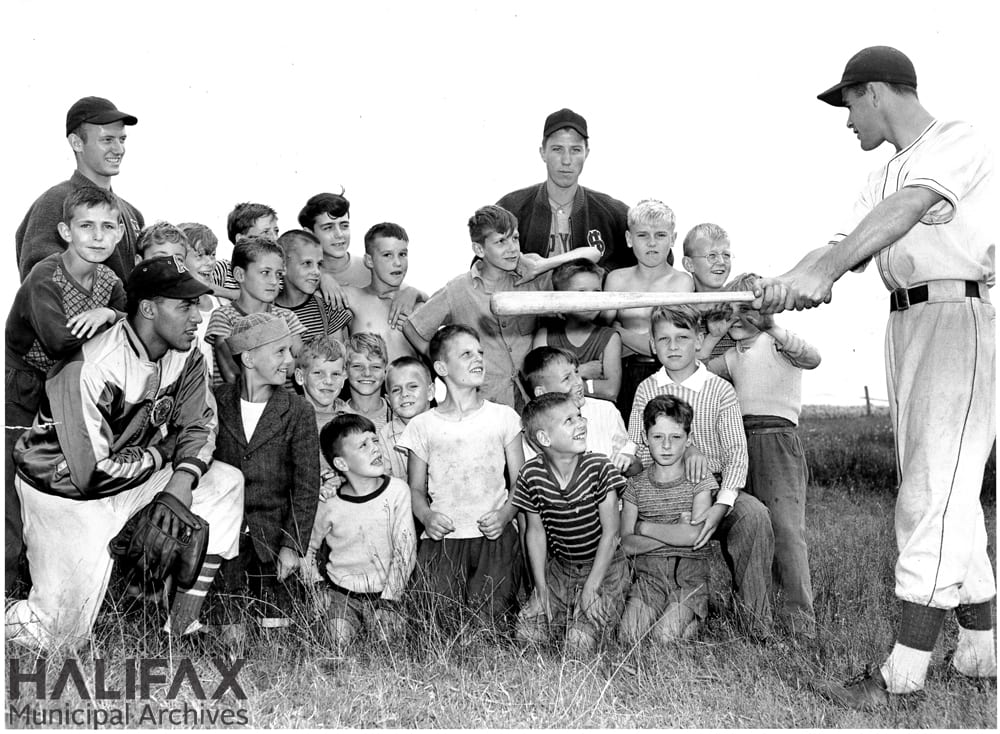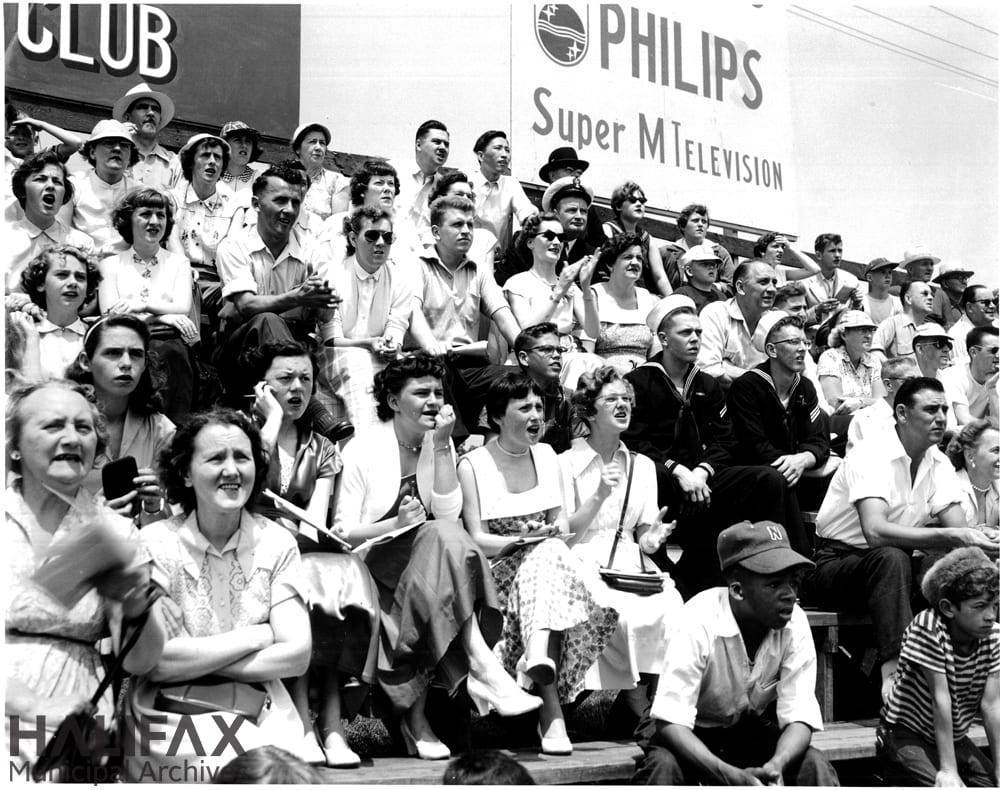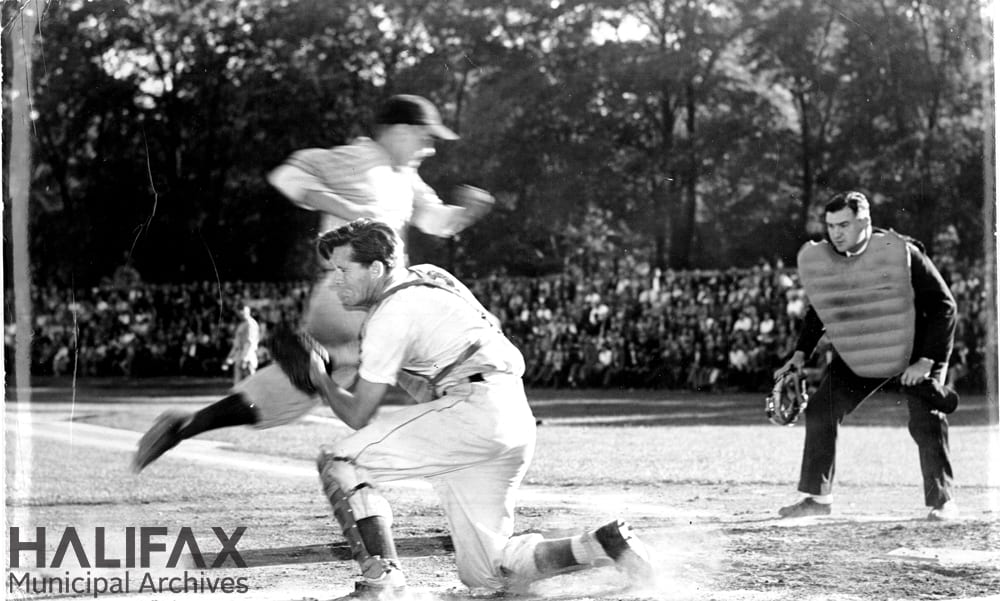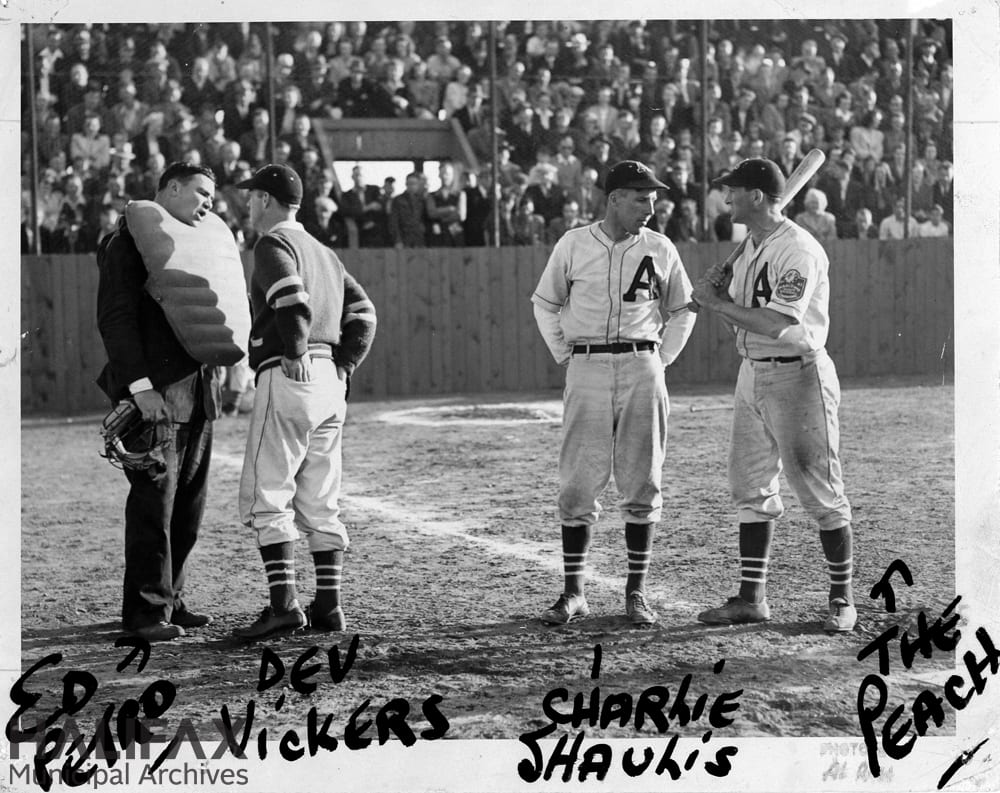Written by guest bloggers, Dave Cogswell and Elena Cremonese, Archivists at Halifax Municipal Archives
We have a confession to make: neither of us is actually a big fan of baseball. So when the Halifax Municipal Archives received a transfer of photographs from the Nova Scotia Sport Hall of Fame, opens a new window in 2020, including a number of photographs from the Halifax and District Baseball Leagues, there wasn’t an obvious person to start the task of describing the collection. Of course, you don’t have to be passionate about the material to describe it—but it can certainly help!
But this collection and the process of describing really sheds some light on the ways that history comes alive when you take the time to really explore it—even the history of sports you might otherwise find…a bit slow.
You may be surprised, as we were, to learn how early baseball arrived in Halifax. Baseball was introduced to the Maritimes in the 1860s, and local clubs and teams quickly sprung up across the region providing communities with leisure and entertainment opportunities. The first reported baseball club from the Halifax region was the Halifax Baseball Club, established in the spring of 1868. Halifax teams were typically organized around shared occupations (e.g., the Mechanics, the Labourers), neighbourhood teams (e.g., the Southends, the Northends), or company teams (e.g., the Heralds, the Chronicles, Taylor's Factory).
Social impacts
While baseball is often considered “America’s pastime” and a foundational recreational activity throughout North America, neither of us ever completely understood just why baseball is so popular and ubiquitous until diving into its history—especially in a local context. Baseball played an important role in democratizing sports and leisure activities in the late 1800s and early 1900s, bridging divisions of class and religion. Unlike many leisure activities that were reserved for the upper classes, baseball required very little equipment, had fairly simple rules and could be played on any decent-sized field. This made it popular among the working class, and baseball really took off in labour and industry-based communities.
One of the early leagues that stands out in this regard is the Colliery League in Cape Breton, which ran from 1936 to 1939. The Colliery League essentially operated as a mining company league, and experienced all the tensions and difficulties which doomed the later Halifax and District Baseball League (1946-1959). The Colliery League was also a semi-professional league, using a mixture of local players (many of whom were also miners, if you can possibly imagine digging in a mine all day and then playing a ball game later that evening) combined with imported players. Like the H&D League, there were tensions about local amateurs versus imported professional players, both philosophically as to the nature of sport in general and in practical terms in the decreased opportunities for local players. The Colliery League’s collapse may have been expedited by the outbreak of WWII, but the factors that all but assured its demise were already well in place.
The democratic nature of baseball is clear in other ways as well. Women began playing baseball, as well as softball, and there were several notable Black baseball teams across the region in the 1890s and early 1900s. This included the Amherst Royals, the Fredericton Celestials, the Truro Victorians, the Stanleys and the Seasides in Dartmouth, as well as the Eurekas, the Independent Stars, and the North End in Halifax.
Moralistic social movements such as the Temperance Movement promoted baseball as a wholesome diversion from social woes like idleness, drunkenness, and juvenile delinquency, which were considered especially prevalent among the working class.
Ultimately, baseball teams helped build community identities, particularly in rural or industrial communities. Understanding this history helped us to understand why the post-war generation has such a deep love for the sport.
Photos from the Nova Scotia Sport Hall of Fame
Even though we may not always find baseball to be the most interesting game to watch—no offence to baseball fans!—historical action shots can really make the game, and the past, come alive. There’s something about these gameplay photos, rather than a static team image, that helps to envision the time period, and what it would have been like to be at the game, especially if you can see the crowd in the background.
Another element of archival work that can really make photos come alive is the research that goes into describing them, including identifying people and places in the photos. When we received the photographs from the Nova Scotia Sport Hall of Fame, they kindly provided a copy of the descriptive information from their database which gave us a good starting point. Some players were identified, some were partially identified, and many were complete unknowns. Dave’s process was to correct or enhance any information we already had, try to fill in the gaps for the partially identified photos, and then tackle trying to identify the unknowns.
A lot of the images had some information written on the backs, typically players’ names though not often complete. From this information, Dave was often able to improve descriptions or correct information which hadn’t been transcribed accurately. Sometimes a player would be identified in one photo and he would recognize him in others as well, allowing him to update those descriptions. Because so many of the players in the H&D League were semi-professionals and cycled in from similar leagues elsewhere (especially leagues in the northeastern United States), Dave reckoned there was a good chance he could find information about them online. Sure enough, he found several websites dedicated to various baseball minor leagues in the U.S. that were quite useful. These sites helped him correct spellings of names or provide full names for players for whom he might only have had a first initial and the last name.
Nicknames were a particular challenge—you wouldn’t believe how many guys were nicknamed “Red” in the 1940s and 1950s! A lot of players were identified by a nickname and last names, such as “Red” Burchell, or “Preacher” Mustain. Some of the full names of these players were found on various minor league baseball websites. Dave was able to track down a lot of them by searching for online obituaries. The general age of the players in these leagues in the 1940s and 1950s means that, sadly, many have been passing away in the past decades. Fortunately, many of these former players stuck with their nicknames throughout their life and left detailed obituaries which often referred to their time playing baseball.
One of the things that’s always fascinating about archival research is what comes alive even when you’re looking at very specific records. Prior to receiving these photos from the Nova Scotia Sport Hall of Fame, I probably wouldn’t have taken the time to look into the history of baseball in Halifax. But the details from the photos, and the historical details that came up in the research for the exhibit, really bring alive not just the sport, but what life was like in the city as baseball was growing popular and as leagues were developing. It’s not just the history of baseball, but the history of a city through significant changes; baseball is a way into the lives of the people who played and watched the games.
Learn more
To learn more about the history of baseball in Halifax, check out our exhibit,, opens a new window or look through the images in our database., opens a new window
Resources
Howell, Colin. (1995). Northern Sandlots: A social history of Maritime baseball. University of Toronto Press Incorporated.
Howell, Colin. (1989). Baseball, Class and Community in the Maritime Provinces, 1870-1910. Social History, Vol. XXII, no. 44 (November 1989), 265-286.
Townsend, Hugh. (2006, August 9). Celebrating a great era for baseball in Pictou County. The Pictou Advocate, p. 13.
Townsend, Hugh. (2006, August 30). Up and down 1953 season for the Stellarton Albions. The Pictou Advocate, p.13.
Townsend, Hugh. (2006, September 13). The end of a great baseball league. The Pictou Advocate, p. 11.
Halifax and District Baseball League. (2014, March 11). Retrieved from https://maritimebaseball.wordpress.com/2014/03/11/halifax-and-district-baseball-league/
Halifax Defence League. (2016, July 21). Retrieved from https://maritimebaseball.wordpress.com/2016/07/21/halifax-defence-league/
Timeline of High Level Baseball in the Maritimes. (2018, May 30). Retrieved from https://maritimebaseball.wordpress.com/2018/05/30/timeline-of-high-level-baseball-in-the-maritimes/









Add a comment to: Halifax Municipal Archives: Baseball in Halifax